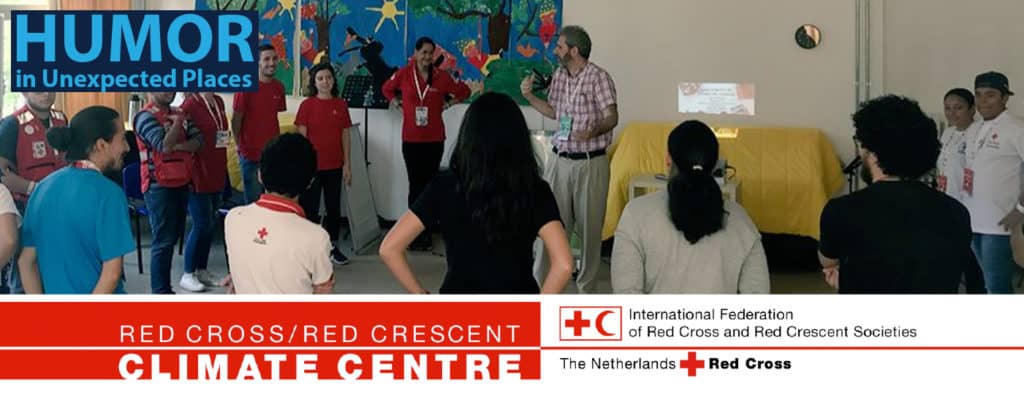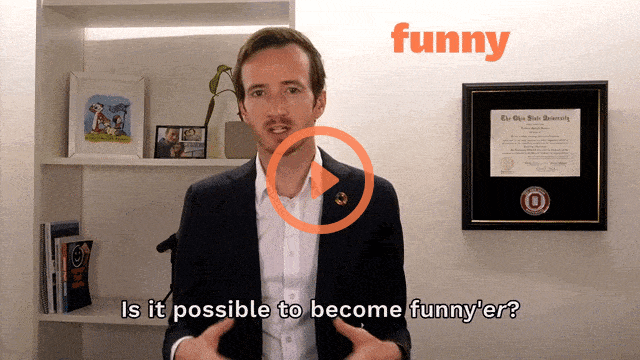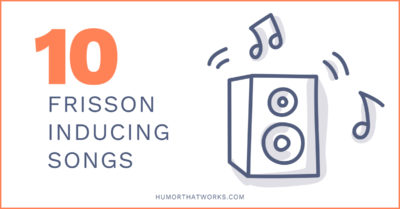On February 19, 2018, I opened my inbox and was excited to see the following email subject line: Harnessing Humor for Humanitarian Work: Drew + Red Cross?

I was excited because that is some excellent alliteration. And because, while I love the work we do empowering individuals at corporations all around the world, it’s great when we can also partner with nonprofits and community organizations who are having a positive impact.
Why humor for humanitarian work?
Dr. Pablo Suarez, associate director for research and innovation at the Red Cross Red Crescent Climate Centre, was interested in exploring the use of humor in disaster management and was looking for guidance. I was familiar with some of Pablo’s work as we had met at a conference a few years prior.
He’s an avid learner and always seeking innovative solutions for the humanitarian sector, including turning disaster data into 3D sculptures, playing participatory games for disaster preparedness at the White House, and taking edible insects to a UN conference in Paris.
Pablo’s next focus was on incorporating more humor. Why? As he put it, it’s a “most promising avenue that has been outside the formal comfort zone of colleagues in disaster management and related disciplines.” Humor can be a powerful communication tool and I was excited about the idea because humor can encourage people to accept complex arguments. And humanitarian emergencies are inherently complex.
What type of humor was used?
Over the course of the next few months, we worked with Pablo on incorporating humor into his presentations on geoengineering. This included some general guiding principles for using humor, some specific strategies for using humor to improve communication, as well as some one-on-one coaching and script-writing of possible humor to use, including:
- Incorporating a few more images into his presentation, such as a picture of Pablo and his Nonna.
- Creating associations that connected key points of the presentation to subjects the audience would find interesting, including a reference to Mary Poppins.
- Building up the humor in a couple of existing stories, adding more details and asides.
What were the results of using humor?
From Pablo:
“When energy level was dwindling due to complexity in the Geoengineering presentation, I explained how one proposed solution is like ‘Mary Poppins with a gigantic umbrella blocking sunlight reaching Earth.’
I feared that half of the participants would not know the reference and the other half might find it cheesy… But the comment elicited a loud, wholehearted popular laugh, which energized those who laughed and reconnected those who were beginning to fall asleep…
The room became engaged again, just in time to deliver the more humanitarian messages.”
Pablo wasn’t satisfied in “feeling” like the students were more engaged, he wanted proof. So he recorded the audience and used emotion analytics to track the mood of participants during the talk.
The tool uses “facial affective information” to determine an individual’s mood and tracks level of engagement, joy, and surprise in an audience.
You can see in the image below that engagement and joy both spike up at the mention of Mary Poppins:

What was also interesting to note were the survey results from the workshop.
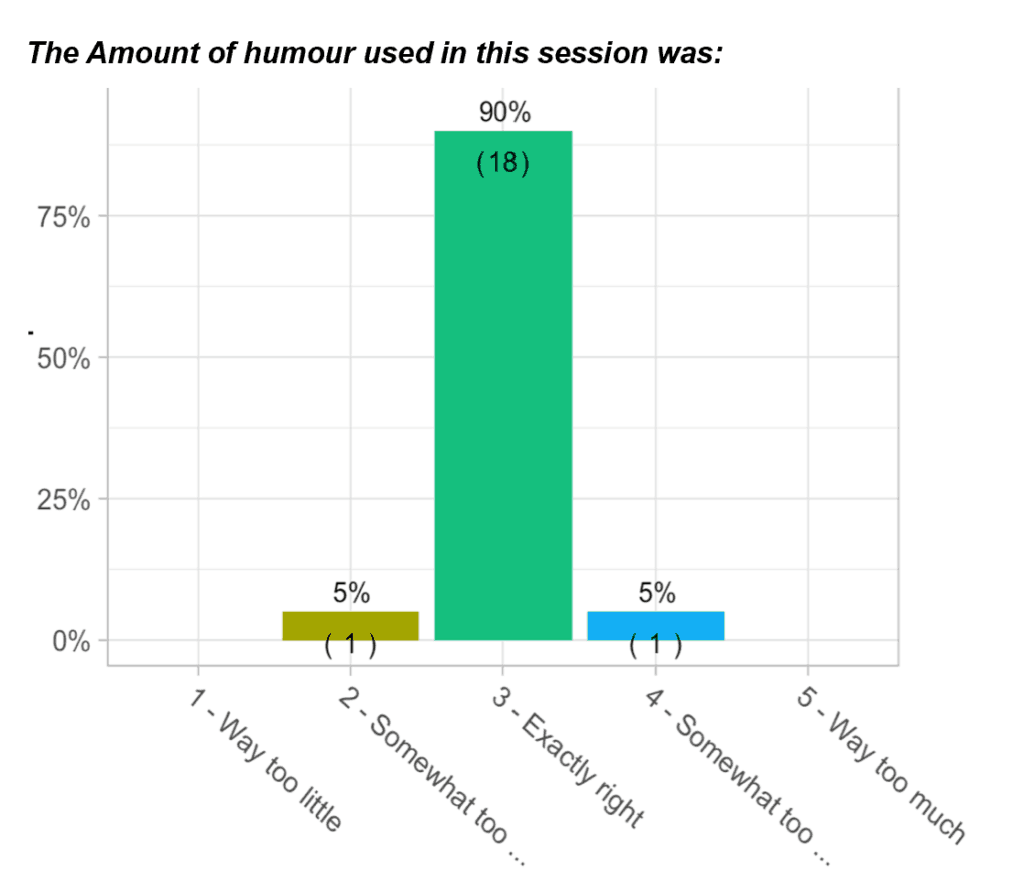
You’ll notice a few things when looking at this graph. One is that Pablo uses the British spelling of “humour,” and two is that the sample size isn’t very large (n = 20).
But, more importantly, when answering the question about “the amount of humor used in this session,” 90 percent of respondents answered that it was “exactly right.”
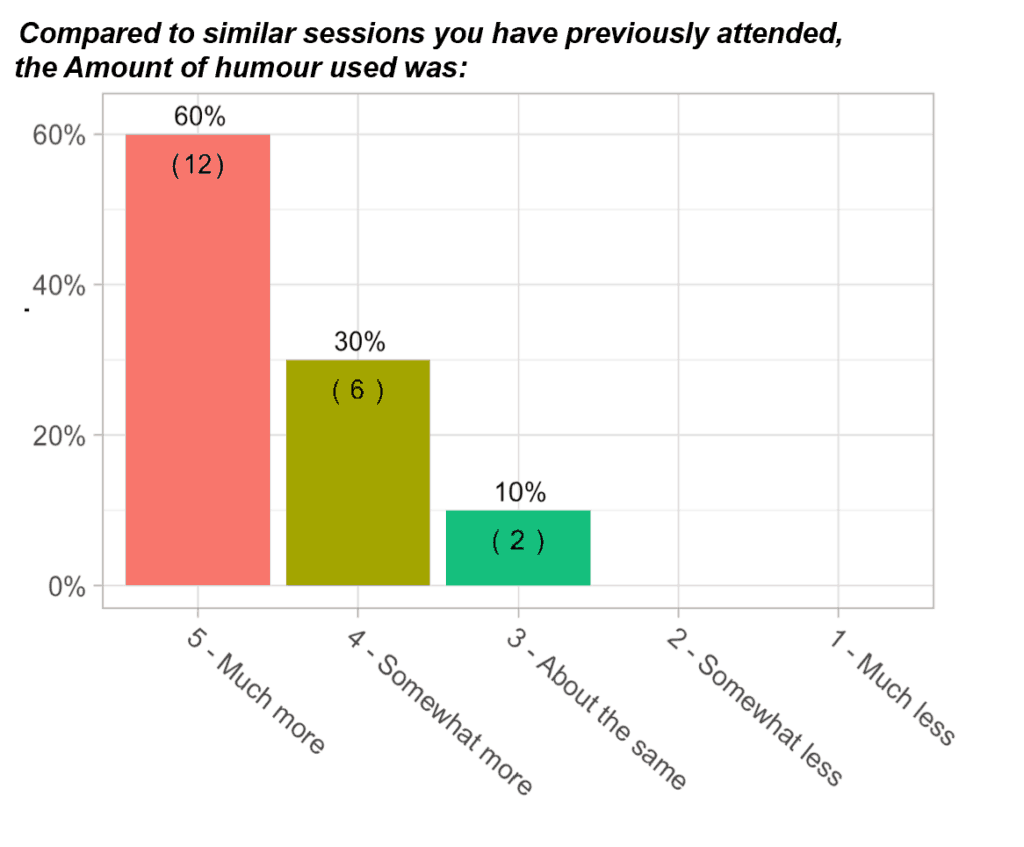
When compared to similar sessions the participants had previously attended, 64 percent said the amount of humor used was “much more” and 30 percent answered “somewhat more.”
As Pablo summarized,
“Thus, we can conclude that a very large proportion of participants found that ‘much more humor than usual’ was the ‘exactly right’ amount of humor. This is interesting, especially given that a large majority of participants found the subject matter itself inherently ‘very serious’ and that they found the session content ‘very useful.'”
What can we learn from this?
There are a few important ideas that almost any group can learn from Pablo’s use of humor:
- Humor is a valuable skill in making sure people hear the messages that could save (or dramatically improve) lives. It also increases the likability of the speaker, which means more people will listen.
- In most corporate settings, people are so starved for engaging content that “much more humor than usual” is likely the “exactly right” amount of humor. This helps appeal to a wider audience than just subject matter experts.
- You don’t have to do this work alone. Pair up with a co-worker or friend who can help you find ways to add humor to your work. Or partner with us.
No matter the focus of your talks, if you deliver presentations to humans, humor is an effective tool for increasing engagement, and retention, of your message.
As Pablo shared with me, “The impact [of humor] was… well, simply put: joyful to experience—and effective to get better (serious) results… I fully see why your company is called ‘Humor That Works’ :).”
UPDATE (12/10/18): A few months after Pablo’s successful case study of humor, he shared the value of humor at the UN Climate Change Conference in Poland.
UPDATE (7/16/19): Pablo shared some of the results of his work in a TEDx talk entitled, Harnessing humor for humanitarian work.
This post is a part of our series on Humor in Unexpected Places.
A version of this story appears in our book, Humor That Works.

